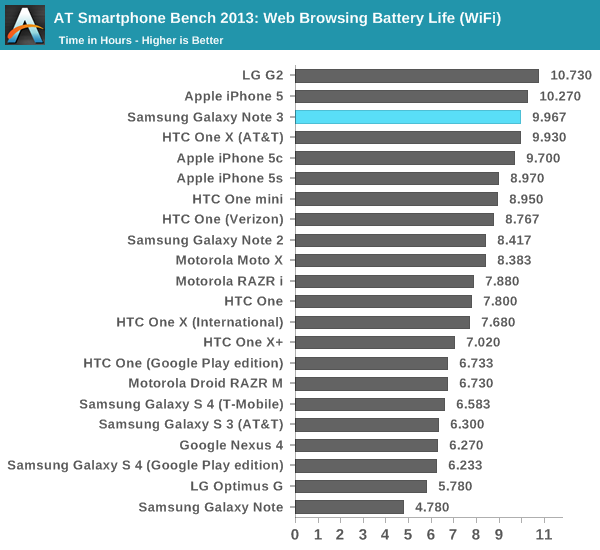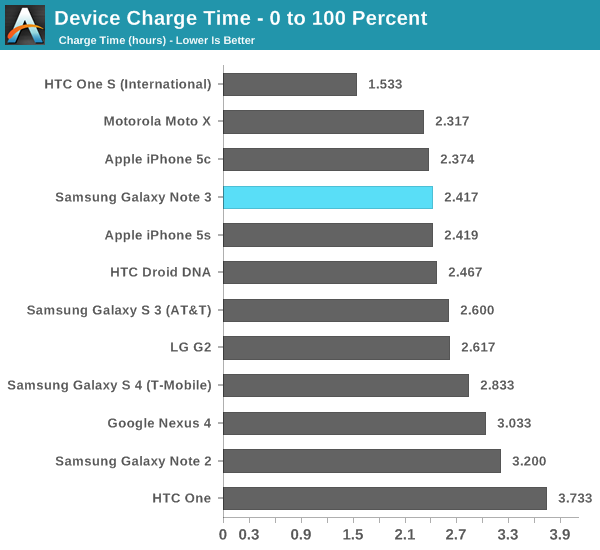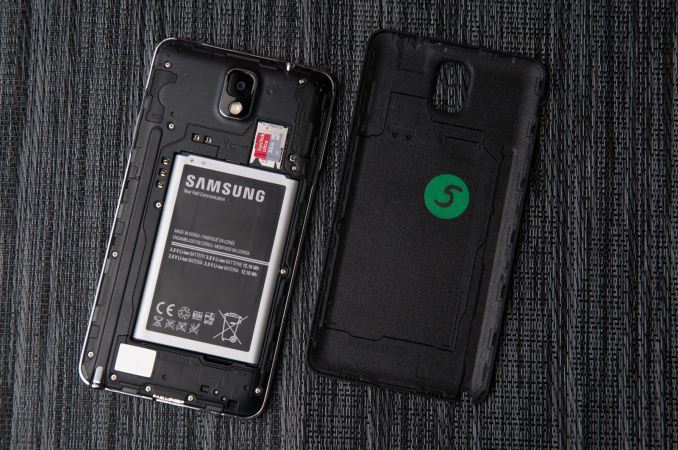Samsung Galaxy Note 3 Review
by Brian Klug on October 1, 2013 9:00 AM EST- Posted in
- Smartphones
- Samsung
- Mobile
- Android 4.3
- galaxy note 3
Battery Life
Battery life remains probably the single largest differentiator for devices lately, and of huge concern to enthusiasts and normal shoppers alike. We’ve already caught a glimpse of how well 8974 fares from a power perspective inside the LG G2, a device that posted some seriously impressive battery numbers. The Note 3 we’re looking at is also 8974 based since it’s a T-Mobile model, and thus we expect the same kind of battery life.
With this generation of Note, battery gets even larger. The Note started with a then quite large 9.25 watt hour battery, then Note 2 moved to 11.78 watt hours, and Note 3 now moves to a very large 12.16 watt hour battery with of course the newest 3.8V chemistry and all that comes along with it. Display size goes up, but those power gains are offset in other places.
After we talked about the panel self refresh features in the G2 a few people reached out and let me know that this feature has been shipping for a while in some phones, and it’s easy to check for. If we look under the display subsystem we can see that the same MIPI_CMD_PANEL type 9 is used, which refers to this type of interface.
Qualcomm HWC state: MDPVersion=500 DisplayPanel=9
define MIPI_CMD_PANEL ‘9’
Our battery life tests are unchanged and consist of a set of popular webpages that are loaded on a schedule with the display set to exactly 200 nits and repeated until the battery runs out and the device dies on both WiFi and cellular data connections. In this case that means T-Mobile LTE which is 10 MHz FDD in my market, I haven’t had a chance to run the Note 3 on HSPA+ yet, or complete the call test (which is starting to get ridiculous, and probably breaks 24 hours in the case of the Note 3).

On LTE the Note 3 does very well, coming just shy of the pack of iPhones, at just over 8 hours. Interestingly enough it’s just north of the G2s as well, which do have a smaller battery but also smaller display. The Note 3 also is the first device to ship with Qualcomm’s QFE1100 envelope tracker solution from the RF360 front end portfolio, which lowers power consumption by up to 20 percent and heat dissipation by up to 30 percent by allowing the power amplifiers to follow the desired output waveform. There’s more on that later in the cellular section.

On WiFi the Note 3 does better by 22 percent, but not the kind of huge jump I’m used to seeing between cellular and WiFi testing. This tells me the Note 3 battery life is really gated by the display, which is almost always the largest consumer of power in a device. That said the Note 3 does very well all things considered, especially in comparison to the APQ8064 (Fusion 3) phones which came before it, like SGS4. New silicon and new process inside MSM8974 definitely helps move battery life forward here with the race to sleep game.
Charging is an interesting story on the Note 3, but primarily because of what doesn’t change. The Note 3 continues to use Samsung’s tablet charging specification and charger, which has 2 amps of maximum output. The Note 3 draws 2 amps over a considerable amount of the charging curve, like other Samsung devices (in the linear part of the charge curve). USB 3.0 doesn’t change things up here quite yet with the new supported charge voltages that are coming eventually with the power delivery specification.

The Note 3 does charge faster overall compared to the SGS4 however thanks in part to the new PMIC (PM8941) which is part of the overall 8974 platform story.











302 Comments
View All Comments
Nathillien - Tuesday, October 1, 2013 - link
You whine too much LOL (as many others posting here).vFunct - Tuesday, October 1, 2013 - link
I agree that it's cheating.The results don't represent real-world use. Benchmarks are supposed to represent real-world use.
Geekbench actually runs real programs, for example.
Che - Tuesday, October 1, 2013 - link
Since when do canned benchmarks really represent real world use?I don't have a dog in this fight, but benchmarks are very controlled, tightly scripted, and only give you details on the one thing they are measuring. The only way to define real world performance is by..... Using said device in the real world for a period of time.
I care more for his comments on the actual use of the phone, this will tell you more than any benchmark.
doobydoo - Saturday, October 19, 2013 - link
They are meant to be a way of measuring the relative performance that you'll get with real world use.Whatever the actual benchmark, provided some element of that benchmark is similar to something you'll do on the device, the relative performance of different phones should give you a reasonable indication how they will relatively perform in real world use.
The problem is when companies specifically enable 'benchmark boosters' to artificially boost the phone above what is normally possible for real world use, and thus the relative scores of the benchmark which were previously useful are not.
darwinosx - Tuesday, October 8, 2013 - link
So you are a kid that owns a Samsung phone. Yes, it really is that obvious.Spunjji - Tuesday, October 8, 2013 - link
Handbag.runner50783 - Tuesday, October 1, 2013 - link
Why is this cheating?, is not that they are swapping CPUs or anything, the SoC is still running under specification, so, get over it.What this make is benchmarks irrelevant, because Manufactures can tweak their kernels to just get better scores that do not reflect daily use.
Chillin1248 - Tuesday, October 1, 2013 - link
No, it is not running under the specification that the consumer will get.They raise the thermal headroom, lock the speed to 2.3 ghz (which would normally kill battery time and cause heat issues). Now if Anand would test the battery life while looping the benchmark tests, then it would be fine as the discrepancy would show up. However, he uses a completely different metric to measure battery life.
Thus, Samsung is able to artificially inflate only their benchmark scores (the only time the "boost" runs is during specific benchmark programs) while hiding said power usage to get those scores.
vFunct - Tuesday, October 1, 2013 - link
It's cheating because the resuts can't be reproduced in the real world for real users.Geekbench uses real-world tests, and they need to represent real use.
Samsung artificially raises the speed of Geekbench so that, for example it's BZip2 compress speeds can't be reproduced when I run BZip2 compress.
Samsung doesn't allow me to run BZip2 as fast as they run it in benchmarks. Samsung gives the benchmarks a cheat to make them run faster than what the regular user would see.
bji - Wednesday, October 2, 2013 - link
You know, you'd think benchmark authors would figure this stuff out and provide a tool to be used with their benchmark to obfuscate the program so that it can't be recognized by cheats like this. Whatever values the cheaters are keying off of when analyzing the program, just make those things totally alterable by the installation tool. If the benchmark program ends up with a randomized name, it is still usable for benchmarking purposes and the cheaters cannot tell its the benchmark they are trying to cheat on.Seriously why do I have to be the one to always think of all of the obvious solutions to these problems!??! Same thing happens at work! lol